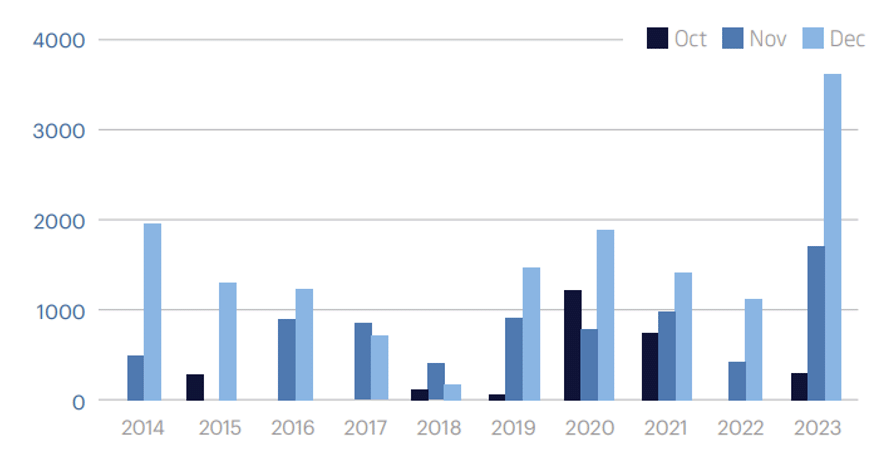
Record catastrophe (cat) bond volume in 2023 stemmed largely from inflation. Although that factor may be moderating, a first-time cyber cat bond early last year gave way to an unexpected rush toward year-end, indicating strong interest from Wall Street investors in a risk transfer market with significant growth potential.
Property cat bond issuance under Rule 144A, which allows private placements to be sold among qualified institutional buyers, reached a record $15 billion, and new cyber cat deals added another $415 million, according to Artemis. Much of the cat bond activity overall was in the fourth quarter, including four new cyber deals.
Outstanding volume rose 21%, to $42.9 billion, from $35.5 billion in 2022.

Cat bond and ILS issuance in fourth quarters, by month (source: Artemis).
Jean-Louis Monnier, head of insurance-linked securities (ILS) at Swiss Re, said that amid the inflation trend, insurers facing significantly higher property-replacement values required greater insurance capacity. Reinsurers’ relatively stable capital didn’t increase sufficiently to meet insurers’ risk-transfer needs, he said, another factor behind the cat bond issuance.
“Inflation increased demand for reinsurance by around 25%,” while reinsurers’ balance sheets contracted by a similar percentage, said John Seo, co-founder and managing director of ILS-focused Fermat Capital Management.
Monnier foresees continued cat bond growth even with inflation declining, “but at a more moderate pace. We would not be surprised if it’s $47 billion by year-end.”
Favorable for Investors
Cat bond volume was also aided by attractive returns, totaling 19.69% for the year, according to the Swiss Re Cat Bond Performance Index.
Those returns drew more generalist funds into the market, especially to “sidecar” private ILS vehicles, said Bill Dubinsky, CEO of Gallagher Securities, the capital markets arm of Gallagher Re. “Most of the increase in assets under management came from existing dedicated funds gathering more assets from end-investors they already had relationships with,” he added.
Another plus was that last year’s significant losses stemming from natural catastrophes, especially severe thunderstorms, were absorbed primarily by insurers and reinsurers.
Richard Pennay of Aon Securities
“Cat bond investors received much higher margins, and they weren’t subject to big losses from a great natural catastrophe, so it was a historic year,” said Richard Pennay, CEO of ILS at Aon Securities. Returns well into double digits “enabled the market to satisfy much of the demand from insurers and reinsurers to diversify their capacity.”
Artemis reported on a bullish forecast by Aon: “The exposures that risk managers cite as their main concerns all tie into parametric solutions, such as business interruption and supply chain/distribution failure. In addition, risk managers around the globe are increasingly focused on protection against cash flow/liquidity risk.”
As demand for and confidence in parametric risk transfer are growing, “innovation across the sector will increase, both within established perils (such as natural catastrophe and weather) and in new perils (e.g., cyber, marine cargo, and a wide variety of other indices),” Aon said.
Tradeable Cyber Deals
As for cyber, the first such offering was completed in January 2023 by Beazley of the U.K. Technically a traditional private deal, the $45 million transaction was structured to be fully tradeable under Rule 144A, and a handful of institutional investors bought the bonds, including Fermat.
At that point, given the market’s traditionally measured approach toward new perils, another one or two transactions were anticipated by year-end. Instead, Beazley came back to the market in December to complete under Rule 144A a $140 million PoleStar Re deal, increased from an initial $75 million, according to Artemis.
Also in the fourth quarter, Chubb and Axis Capital issued cyber cat deals that saw strong investor demand, and Swiss Re issued the first cyber cat bond triggered by industry loss. That’s a key provision for reinsurers because the triggers are based on industry losses calculated by a third party that reach a specified level, rather than by difficult-to-model losses among a reinsurer’s insurer clients.
Market observers anticipate more cyber cat deals, mainly in coordination with traditional policy renewals later this year.
Amounts Going Up
As the cyber cat market grows, insurers will be able to increase their limits on cyber insurance, better meeting clients’ needs.
“Companies looking for $50 million in coverage may have gotten $40 million, and now that additional $10 million may be available,” said Allen Blount, national cyber and technology product leader at Risk Strategies Co., an insurance brokerage and consulting firm.
He anticipates new players entering the cyber cat bond market later in the year, and while the deals may not be numerous, they may be larger, in the $300 million to $400 million range.
Allen Blount of Risk Strategies Co.
Commercial demand for cyber coverage is growing, partly because cyberattacks continue to increase in size and sophistication, and because relatively few companies have sought coverage so far. In a 2023 report, investment management and research firm Conning noted that the U.S. cyber insurance market has been growing 50% annually since 2020. Much of that is due to higher premiums, rather than a broader customer base, and many more customers will be necessary to sustain the current growth rate.
According to Conning, as many as nine out of 10 small businesses may still be uninsured for cyber risk, and insurers will require an influx of capital beyond the traditional reinsurance market, opening the door for more cat bonds.
“Already, there are some indications that investors are growing more comfortable with cyber risk – even in the absence of tried and tested catastrophe risk models,” Conning said.
Extreme and Lesser Hazards
A major catastrophic loss from a black swan event – larger than anything to date and unforeseen by modeling firms, such as a debilitating attack on a major cloud provider or the U.S. power grid – could reverse recent progress. Conning said such a loss could send potentially new capital providers “running for the hills.” It said the Northridge earthquake of January 1994, which resulted in $12.5 billion in insured losses, continues to affect the market for earthquake insurance.
The cyber insurance market’s relatively small size increases the magnitude of price swings in the wake of unexpected losses, and with them the potential impact on the market and its capital providers. As that market grows, the risk diminishes. Conning noted that a $30 billion insured cyber loss in 2023 would be 210% of the annual premium, but only 45% by 2030 if the market continues to grow at the current pace.
“Absent such [large] losses, the [cyber insurance] market can be expected to continue to grow swiftly,” Conning said.
Monnier said growth in overall cyber insurance and with mature models to calculate the risk, an important development last year, will be critical for a robust cyber cat bond market to develop. Investor education about cyber risk market advances is also necessary.
“Investors must integrate cyber risk into their investment guidelines,” Monnier said. “At the moment, the majority of investors cannot take on cyber risk.”
Topics: Financial Markets